Description
CONTENTS
• 6 dice cups
• 24 dice
• 120 game pieces or snake parts / nuggets in red, blue, yellow, green, black and white colours
• Score notepad
• Game rules
• Game board Rattlesnakes
NUMBER OF PLAYERS
All games can be played from 2 players up to 6 players at a time.
1. GOAL
The goal of the game is to be the first one to play all dice away from your cup.
2. GAME TERMS
Value: the value of the numbers on a die from low to high is 2-3-4-5-6-1.
Joker: number 1 on the die is the joker and can be considered to be any number from 1 to 6. A thrown number 1 can also be played as a 1, in which case it is valued higher than a 6. This applies to all game modes of THINKABOXIN.
Bid: a gamble or bluff on the total amount of dice of a certain value that are underneath all players’ dice cups (including one’s own cup).
Raise: raising a bid means that EITHER the amount of dice is raised (e.g. raising four twos to five twos, etc.) OR that the value of the aforementioned amount of dice is raised (raising three fives to three sixes or three ones) OR that both are raised (raising five fours to seven sixes, etc.).
Lift: the player who calls a bid into question, lifts his own dice cup. Afterwards, all players (including the player whose bid had been called into question) lift their cups in order to check who is right through counting the amount of dice with the value named in the last bid.
Won dice: after each round all players – except the player who was not right – can get one die out of their dice cups and put it away. The amount of dice put away is called won dice. Only the dice that can be put away from one’s own cup count as won dice.
Round: one played round (ends when the winning players have been able to put away one die).
Set: all played and counted rounds.
3. GENERAL GAME RULES THINKABOXIN
• Before the start of the game, each player always receives a personal dice cup containing 4 dice.
• All players simultaneously shake their cups with dice, and each player looks underneath his own cup to see what he has thrown himself.
• Players may not ever see one another’s dice (except for when cups are lifted).
• The youngest player starts the very first round. The rounds after that, the loser of the previous round or set begins bidding.
• Whoever starts a round always determines the playing direction. The player determines this through making a bid to either the player to the left or right of him.
• A bid that has been placed cannot be withdrawn or changed.
• Once a bid has been placed, the turn of whoever placed the bid is over, and the next player’s turn is at hand.
• The next player either raises this bid in the given playing direction or lifts his cup if he takes the current bid into question.
• Raise: raising a bid means that EITHER the amount of dice is raised (e.g. raising four twos to five twos, etc.) OR that the value of the aforementioned amount of dice is raised (raising three fives to three sixes or three ones) OR that both are raised (raising five fours to seven sixes, etc.).
• Raising a bid has to be done in the given playing direction.
• In case of a raise, the previous bid no longer needs to be kept in mind.
• When someone lifts the cup to indicate that he takes the previous player’s bid into question, this action is final and cannot be undone.
• When the bid has been taken into question and one cup has been lifted, all players should then lift their cups, and the dice with the values named in the last bid will be counted.
• When more than or precisely the amount of dice named in the bid are present, the bidder is right and the lifter is not right.
• When fewer than the amount of dice named in the bid are present, the bidder is not right and the lifter is right.
• Whoever is not right is not allowed to get any die out of his cup, all other players are allowed to get one die out of their cups.
• The won dice that have been put away from the cups have to be placed in front of the dice cups on the table in a way that is visible for all players.
• The player who was not right starts the next round and can determine once again the playing direction through placing a bid in the desired direction.
• The player(s) who manages to be the first to place all the dice from his cup in front of him on the table wins the set.
• If dice roll out of one or more players’ cups or dice end up lying on top of one another, then these players are The Donkey. This means that all other players can get one die out of their cups. Afterwards, all players shake their cups and the bidding can be started anew by the one (or those) that is (or are) The Donkey.
GAME TERM: KNOCK-OUT RACE
Unlike stated under the GENERAL GAME RULES THINKABOXIN, a knock-out race does not stop when one or more players have played away all their dice from their cups. During a knock-out race, a round will continue until there is one loser left. This loser will be eliminated from the game and barred from further participation to this part. The next set will continue with the remaining players, and the last but one loser starts the round. This will go on until one winner remains.
4. GENERAL TIPS AND TRICKS THINKABOXIN
• At all times, keep an eye on how many dice are in the game at the start of each round. At the start of a 4-player game, 4 x 4 dice = 16 dice are lying underneath the cups. The lowest possible bid is in this case 1 die with value 2 (one two) and the highest possible bid 16 dice with value 1 (sixteen ones).
• It could be useful for the player whose turn is at hand to base his bid on his own dice. True bluffers do not do this. They do not care about which dice they have, and wildly undertake hit-or-miss bids. These unpredictable players give the game an extra dimension.
• Determining the playing direction upon doing the first bid of a round can create a tactical advantage when placing a calculated and sharp bid towards the player who is ahead of the rest of the players.
• When there are 2 dice remaining in the game and these are both ones, the player who at that moment would bid ‘two ones’ wins, rather than the player who would bid ‘two sixes’. The joker is namely also the highest value on a die. In this specific case, both players should of course both have a 1 underneath their dice cups.
5. GAME MODES
Nuggets
• The GENERAL GAME RULES THINKABOXIN apply to NUGGETS.
• Each player receives 10 nuggets before the start of the game.
• Each player shakes his dice in the cup, and the first player of each set can, after checking the dice underneath his cup, determine what the stake for each player will be for this set.
• This stake is either 2 or 4 nuggets.
• All other players will then place the same amount of nuggets as their stake.
• If one or more players do not have any remaining nuggets and are out of the game, the stake for the other remaining players will always be the total amount of nuggets of the player with the lowest supply of nuggets. In that case, the stake could be more than 4 nuggets.
• When a player has no remaining nuggets to put in as stake, the game is over for this player and he can no longer play.
• The pool of nuggets will only be distributed when one or more players have played away all their dice from their cups.
• When there are multiple winners, the pool of nuggets is to be distributed fairly between them.
• Any possible remainder of nuggets will stay in the pool for the next set. When two players win with an uneven amount of nuggets in the pool, the remainder will stay in the pool for the next set.
• The player who has won all nuggets is the winner of NUGGETS.
Goldrush
• The GENERAL GAME RULES THINKABOXIN apply to GOLDRUSH.
• One player (the secretary) fills in the players’ names (in sitting order) and keeps the score for each round on the score notepad.
• 10 rounds are played in total.
1st set = 1 round, everyone starts with 1 die in their cups.
2nd and 3rd set = 2 sets, everyone starts with 2 dice in their cups.
4th until 6th set = 3 sets, everyone starts with 3 dice in their cups.
7th until 10th set = 4 sets, everyone starts with 4 dice in their cups.
• A set is won when one or more players have played away all of their dice from their cups. At that point, all won dice for each player are counted and noted under the players’ names for the relevant set.
• The running scores are continually counted by the secretary and announced to the other players.
• The final score is announced by the secretary, declaring who the (tied) player numbers 1 and 2 are.
• The (tied) player numbers 1 and 2 are pitted against one another in a final knock-out-race.
• The winner of this final is the winner of GOLDRUSH.
The Next Sheriff
• The GENERAL GAME RULES THINKABOXIN apply to THE NEXT SHERIFF.
• During the entire game one-on-one duels are played. Each player duels one another once, until one of the players has played away all of his dice.
• One player (the secretary) fills in the players’ names from left to right and, in the same order, from top to bottom. The secretary also keeps the score for each duel (the amount of won dice per player) on the score notepad.
• The secretary determines at what time which player plays against which player.
• The amount of dice that have been put away from the cup is the amount of scored points. This result is noted directly after each duel by the secretary.
• After all players have played against one another once, the total amount of won dice is counted and noted in the totals column on the right-hand side (Total amount of won dice).
• The score from the totals column is filled in at the lower section (in case two players have a tied score, the winner is defined as that player who beat the other player in a duel). The resulting tournament schedule works in the following way:
With 3 players: no. 1 directly granted place in finals. No. 2 plays against no. 3 for place in finals.
With 4 players: no. 1 plays against no. 4 for place in finals. No. 2 plays against no. 3 for place in finals.
With 5 players: no. 1 directly granted place in finals. Winner of no. 2 against no. 5 plays against winner of no. 3 against no. 4 for place in finals.
With 6 players: no. 1 plays against no. 6 for place in finals. Winner of no. 2 against no. 5 plays against winner of no. 3 against no. 4 for place in finals.
• The winner of the last finals is the winner of THE NEXT SHERIFF.
Last Man Standing
• The GENERAL GAME RULES THINKABOXIN apply to LAST MAN STANDING.
• A knock-out race is being played during the entire game (see explanation KNOCK-OUT RACE).
• One player (the secretary) fills in the players’ names and notes during each set which player has been eliminated and crosses that player’s name out on the score notepad.
• The winner of the knock-out race is the Last Man Standing.
Rattlesnakes
• The goal of this game is to be the first to place all your snake parts (20) on the game board.
• RATTLESNAKES is played on the RATTLESNAKES game board with 20 snake parts per player.
• The GENERAL GAME RULES THINKABOXIN apply to RATTLESNAKES.
• Each player receives 20 snake parts before the start of RATTLESNAKES.
• The amount of snake parts that can be placed on the board per set is determined by the amount of dice won by the player per set.
• After a played set, the player with the fewest won dice is the first to start placing his snake. In case of an equal amount of won dice, the player who was the last to lose can start placing. He also determines in which direction the other players are allowed to place their snake parts.
• If a player, for example, has won 3 dice in a set, he can then place 3 snake parts on the game board. Afterwards, it is the next player’s turn to place his snake parts.
• A snake always begins from one of six snake head squares on the game board, which can be freely chosen by the players.
• Only the first snake part placed by the player can be put on a ‘snake head’ square. Afterwards, no snake parts can be put on a ‘snake head’ square.
• Each square on the game board can be used only once.
• The snake parts that have not been placed yet must be placed in front of you in a way that is visible to all players, so that it is at all times clear which player is ahead or behind on the rest (this can influence the tactics of placing snake parts).
• Placing snake parts on the game board can be done in any desired direction via an adjacent square.
• The final snake part that is placed (the head) in a set is placed (temporarily) upright, so that it is clear from which square the snake slithers onwards into the next set.
• When crossing your own snake (through removing one snake part after winning a set with 4 won dice), the crossed part becomes the head (no extra snake part is therefore placed).
• When snake parts can be placed anew, the snake head is laid flat and it is from this square that new parts must be placed.
• The next round will be started by the player who was allowed to place his snake parts the first in the previous set. He once again determines the playing direction through placing his bid to either the left or right (note: a tactical advantage can be gained through this action).
• Once a player has chosen to go into a snake pit by having a snake part stand on an orange square, that player is then obliged to let his next snake part appear at another snake pit on an orange square.
• It is forbidden to immediately re-use an already used snake pit. When going out of a snake pit, the snake has to slither ahead on the regular squares. Players can, however, use multiple different snake pits within one game.
• NO snake parts are placed on a snake pit, as snake pits only serve as a passage to and from another snake pit.
• When winning a set (all dice are out of the dice cup) the player (or players) has the following options:
EITHER place 4 snake parts,
OR remove 1 snake part of your own,
OR remove 1 adjacent snake part of your opponent (this snake part is then given back to the player in question). However, this cannot be done to a snake belonging to a player who has also won this set with 4 dice.
• The player who is the first to put his entire snake on the board wins RATTLESNAKES!
• Should multiple players manage to put their entire snakes on the board within one set, a final round is organised for these players in the form of a knock-out race (see explanation KNOCK-OUT RACE).





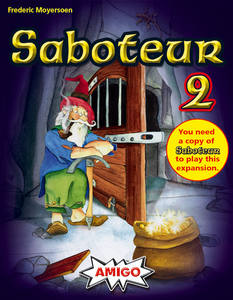


Comments (0)